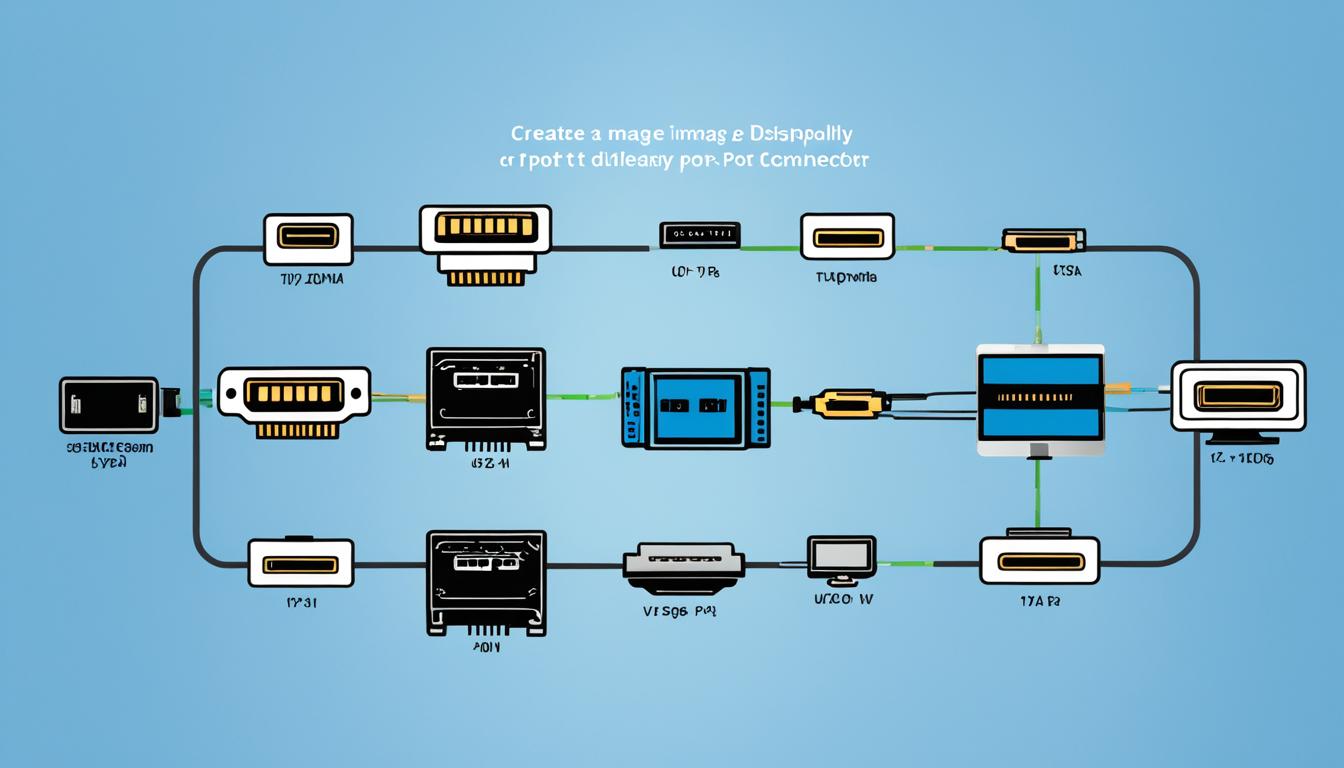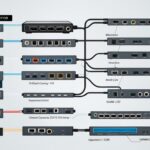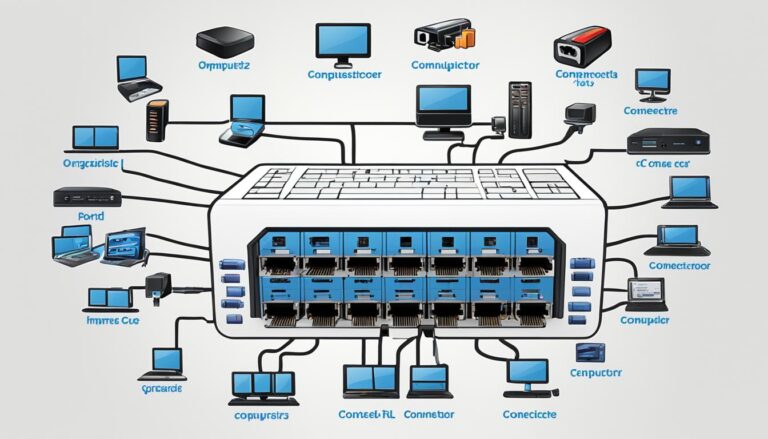Welcome to our guide on display ports and what makes them special. We will look at the different types available today. This will help you choose the right display port for your needs.
Display ports connect monitors, TVs, and other devices to your computer or multimedia gadgets. As technology improves, so do display ports. They now offer better performance, improved image quality, and more compatibility.
Knowing about display ports and their features is key. It helps enhance your multimedia experience and ensures smooth connectivity. This is important whether you’re a gamer, a multimedia lover, or a professional looking for the best display quality.
We’ll cover the evolution of display ports, from old VGA ports to the new USB-C and Thunderbolt ports. Let’s discuss each port’s function, pros, and cons. This will help you pick the best display port for your needs.
Let’s start this adventure and learn about display ports. Keep reading to uncover how each port’s unique features can improve your multimedia experience.
The Evolution of Display Ports: From VGA to HDMI
Display ports have evolved significantly from the VGA days. With new tech, better ports were created to meet consumer needs. Today, we have options like DVI, HDMI, and display port. Let’s explore how these changes have shaped our device connectivity.
The story began with VGA, the early standard for monitors. VGA was an analog port supporting 640×480 pixels. But when HD content became standard, VGA’s limits were clear. This led to the creation of the DVI port.
DVI, or Digital Visual Interface, succeeded VGA. It handled analog and digital signals, offering versatility. Its support for higher resolutions made it popular for those wanting better visuals.
Then, HDMI took the stage. The High Definition Multimedia Interface was a game-changer. It sent audio and video together, making it preferred for TVs and games. Its HD support and convenience made HDMI a household name.
Next, the display port arrived, developed by the Video Electronics Standards Association. It was an HDMI alternative, supporting high resolutions and more data. It gave makers a cheaper, flexible solution for display designs. As tech progresses, display port is becoming a strong HDMI competitor.
“The evolution of display ports has greatly improved our device connections. From VGA to HDMI and display ports, each advancement met a need for better quality and function.”
Exploring display ports further, it’s key to know their history and features. For gamers, designers, or multimedia fans, the right port can enhance your experience. We’ll break down each port’s capabilities, aiding your display choices.
VGA Port: The Legacy Connection
The VGA port, short for Video Graphics Array, is a notable old-school connection. It came out in 1987 and quickly became vital for connecting monitors. It used analog signals to show video.
Its success was due to its wide use and compatibility with many devices. It worked well for computers, laptops, and gaming consoles. These could connect to monitors and projectors easily.
Yet, the VGA port is not as common now. New tech and digital standards like DVI, HDMI, and DisplayPort have taken over. They provide better image quality and support higher resolutions.
The VGA port still has uses for some old hardware. But, it faces limitations in the modern digital world. The analog signals it uses can get interfered with, leading to poorer image quality.
The VGA port is still cherished by many due to its historical value. It shows how far display connections have come.
Now, newer display connections are more popular. The VGA port is mainly found on older devices. It’s used where analog connections are necessary.
However, it’s slowly getting replaced by more modern connections. These new standards promise better image quality and faster data transfer speeds.
| VGA Port | DVI Port | HDMI Port | DisplayPort |
|---|---|---|---|
| Analog Signal Transmission | Both Analog and Digital Signals | Both Audio and Video Signals | High Resolutions |
| Lower Image Quality | Superior Image Quality | High-Definition Multimedia | Cost-Effective Benefits |
| Legacy Connection | Digital Successor to VGA | King of Multimedia | Growing Competitor of HDMI |
Knowing about different display ports and their functions is crucial. This info helps users choose the right connection. It ensures the best performance and compatibility with their devices.
DVI Port: The Digital Successor to VGA
In the world of display ports, the Digital Visual Interface (DVI) port stands out. It follows the VGA port but with a big upgrade. It can send both analog and digital signals. This makes it a flexible choice for hooking up monitors and other display devices.
Designed to take over from the VGA port, the DVI port adds digital signals. This boosts the picture quality and clarity. It’s perfect for high-res screens.
There are three main kinds of DVI ports: DVI-D, DVI-I, and DVI-A. DVI-D is for digital only. DVI-I handles both analog and digital. And DVI-A is all about analog signals.
A key feature of the DVI port is its ability to work with VGA devices. By using the right adapter, you can connect a DVI device to a VGA monitor. This makes it easy to use with older setups.
Moreover, the DVI port supports various screen resolutions. From standard to high definition, even to ultra-high-definition with dual-link. This makes it a top pick for gamers, graphic designers, and anyone after a crisp visual experience.
Yet, the DVI port isn’t perfect. It can’t carry audio signals, unlike HDMI or DisplayPort. Also, as new display ports appear, DVI’s popularity has dipped a bit.
Still, for those who value top-notch visual quality and flexibility, the DVI port is a strong choice. Its dual signal support is a major advantage for many devices and uses.
HDMI Port: The King of Multimedia
The HDMI port has changed how we enjoy media. It stands for High Definition Multimedia Interface. HDMI sends both sound and picture, making it perfect for gadgets like TVs and consoles. It offers high-quality digital signals, making it the top choice for a great audiovisual experience.
One big plus of HDMI is it keeps audio and video quality superb. There’s no loss in quality. This means movies, shows, and games look amazing and sound clear. It brings your entertainment to life in a way not seen before.
HDMI also supports beyond just standard definition. It handles up to 4K Ultra HD, ensuring crisp images and bright colours. So, whether you’re into movies or video games, HDMI makes everything look spot on.
As technology advances, HDMI keeps up. There are now versions like HDMI 2.1. It offers even better resolution, refresh rates, and dynamic HDR. This means your viewing experience gets even more immersive and realistic.
HDMI is now a key player in multimedia. It’s versatile and widely used. Its ability to carry both audio and video makes it easy for both consumers and makers. Setting up your home theatre or gaming setup? Streaming from your laptop to your TV? HDMI makes all this smooth and top-quality.
DisplayPort: The Growing Competitor of HDMI
The DisplayPort is becoming a key rival of HDMI in audio and video transmission. Developed by the VESA, it offers high-resolution and cost-effective solutions. It’s a great choice for those needing top quality.
One big plus of DisplayPort is it supports high resolutions. This is perfect for designers or gamers wanting clear images and smooth videos. It can go up to 8K resolution.
DisplayPort is also great for audio. It lets you enjoy multi-channel audio without losing video quality. This is ideal for home theaters, gaming, and multimedia uses.
It’s cost-friendly for makers too. The cables are thin and light, which cuts down on costs. The daisy-chaining feature lets you connect several monitors to one output. This means less clutter.
In summary, DisplayPort is a strong HDMI competitor. It supports high resolutions and audio while being cost-effective for manufacturers. As technology advances, knowing about different ports helps in making the right choice.
Comparison between DisplayPort and HDMI
| DisplayPort | HDMI |
|---|---|
| Supports high resolutions up to 8K | Supports high resolutions up to 4K |
| Supports multi-channel audio | Supports multi-channel audio |
| Thin and lightweight cables | Standard-sized cables |
| Daisy-chaining support | No daisy-chaining support |
| Cost-effective solution for manufacturers | Widely used and compatible with various devices |
USB-C and Thunderbolt: The Future of Monitor Connections
The way we connect monitors is changing fast. USB-C and Thunderbolt ports are leading this change. They are making connections more flexible, easier, and offer more options.
The USB-C Port: A Unified Solution
USB-C port is a big step forward in monitor connections. It combines many ports into one, like HDMI, DisplayPort, and USB-A. It is small and easy to plug in any direction.
Notably, the USB-C port allows for fast data transfer and charging. It also lets you connect monitors with just one cable. So, you don’t need many cables and adapters anymore.
The Thunderbolt Port: Unleashing the Power of Connectivity
The Thunderbolt port is another game-changer. Intel and Apple created it. It does everything the USB-C can but much faster.
Thunderbolt can move data at speeds of up to 40 Gbps. It’s great for things like video editing and playing games. Plus, you can link devices together without a mess.
The Future of Monitor Connections
The USB-C and Thunderbolt ports will be key in the future of connecting monitors. They offer a simple and flexible way to connect different devices.
As these ports become more common, connecting will get easier and more efficient. The future looks bright and uncomplicated for users.
| USB-C Port | Thunderbolt Port |
|---|---|
| Replaces multiple connectors | Combines data, power, and video |
| Compact and reversible design | Daisy-chain multiple devices |
| High-speed data transfer | Lightning-fast data transfer |
| Supports video output | Streamlined and clutter-free workspace |
Conclusion
Choosing the right display port means knowing about different types. We’ve looked at display ports from the old VGA to the advanced USB-C and Thunderbolt. Each port has its benefits and limitations for certain needs.
The VGA port was once common but now, DVI and HDMI have taken over. DVI is flexible, working with many resolutions. HDMI, on the other hand, is great for HD audio and video.
DisplayPort is becoming a top choice over HDMI, thanks to its high-quality sound and picture. USB-C and Thunderbolt are the future, making device connections easy and versatile.
By understanding these ports, you can choose the best one for your needs. At Xenarc Technologies, we have rugged LCD touchscreen monitors with various port options. Check out our products for the ideal display solution.
FAQ
What are display ports?
Display ports let devices connect to screens. They send audio and video to the display. This way, users can see and hear content.
What types of display ports are there?
You’ll find many display ports like VGA, DVI, HDMI, and others. Each one fits different needs.
What are the unique features of different display ports?
Every display port has its own strengths. For example, some support high resolutions. Others are great for audio or work well with various devices.
What is the difference between analog and digital signals?
Analog signals flow continuously. Digital signals use codes of 0s and 1s. Digital offers better quality in sound and image.
Which display port is the successor to the VGA port?
DVI is the new era of VGA. It handles both analog and digital signals.
Which display port is commonly used in the multimedia industry?
The HDMI port is a star in multimedia. It’s found in TVs and game consoles. It carries audio and video together.
What advantages does the DisplayPort offer over HDMI?
DisplayPort excels with high resolutions. It’s good for audio too. Plus, it’s cheaper for manufacturers than HDMI.
What is the USB-C port used for?
The USB-C port does it all. It’s used in new gadgets for charging and data. You can also connect other devices through it.
What is the Thunderbolt port used for?
Thunderbolt is all about speed. It connects devices and screens quickly. It’s more versatile than other ports.
Source Links
- https://www.xenarc.com/different-types-of-monitor-ports.html
- https://uniaccessories.com/blogs/blog/types-of-monitor-ports-everything-in-2-minutes
- https://www.quora.com/What-types-of-ports-do-monitors-have-for-input-How-do-they-connect-to-computers-if-computers-only-output-through-one-type-of-connection


















